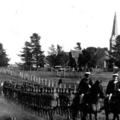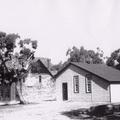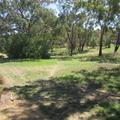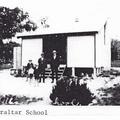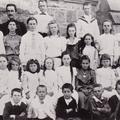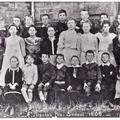< Early Canberra Government Schools
Canberra School [1845 - 1913]
Previous Name/s: Springbank
Beside the Church of St John the Baptist in Reid stands a schoolhouse which probably opened in the year of the church's consecration, 1845. It was a Church of England denominational school, subsidised by the state but built at the initiative and with the financial support of Robert Campbell of Duntroon, who sought the blessings of religion and education for the children of his employees and neighbours. Catholic and nonconformist children were welcome if their parents were prepared to accept that education came at the price of religious instruction in another creed. In spite of its location on Duntroon land it was called Canberry School.
The school had a stormy history, mainly because the land on which it stood was later treated by Campbell's son George as personal property. His interference in school matters, often prompted by friction with teachers, alienated some parents and members of the wider community. Matters came to a head following passage of the Public Instruction Act of 1880, which removed state subsidies from denominational schools. The NSW authorities asked Campbell if they might lease the schoolroom for use as a public school. Campbell told them that he intended to open a private school in the building.
The local Schools Inspector, J H Murray, wrote to the Queanbeyan Age asking if there was support for a public school nearby. This quickly elicited an application for a Provisional school. It was organized by Father Patrick Birch of Queanbeyan and reported that there were 18 Roman Catholic and 6 Church of England children within two miles of Springbank Farm on Sullivan's Creek. William Sullivan was willing to lease a slab and bark hut large enough for 25 children for a 'nominal' £10 p.a. Murray favoured the application but rejected Birch as a member of the school board as not being in accordance with the secular 'spirit of the Act' (and because he was not a resident).
If Father Birch had been hoping to install a Catholic as teacher he would have been doubly disappointed because Murray recommended James Abernethy, previously the teacher at St John's. As part of his induction to the state system Abernethy had to declare that he would 'abstain from giving special religious instruction to the pupils at any time on the school premises' and use only books sanctioned by the authorities. It was the second time that Abernethy had been displaced from St John's schoolhouse: in 1864 it had been gutted by fire and classes were conducted in the Duntroon dairy until repairs could be effected.
The Springbank site was contentious. Children from south of the Molonglo had to cross the river by fords, which the inspector had to concede were impassable even to adults on foot for about two months of the year. Pupil numbers fluctuated and during 1891-2 Springbank was run as a half-time school paired with Nerrabundah ('Long Gully', near Mount Taylor). Numbers recovered sufficiently in 1892 for the Department to erect a weatherboard school about 200 metres south of the Springbank farm buildings but a year later the school again reverted to half-time status, this time with Narrabundah ('Crossroads').
Nerrabundah and Narrabundah had solved the river-crossing difficulty for southsiders but children on the northside were also at risk of being cut off, although in their case the hazard was the leaseholder of Acton, Arthur Brasssey, who sought sixpence per child per year for right of passage and threatened to deny it if there was misbehaviour. Duntroon employees resented the distance their children had to walk. They pointed to the fact that the church schoolroom was disused since the closure of Campbell's private venture (attended by, among others, the Brassey boys). They promised to send their children to this more central location and in 1895 Springbank was abandoned in favour of reopening a full-time public school at St. John's.
By then the half-century old building was in a bad way but there was an additional complication in that the school lease did not include its attached teacher's residence. When teacher Duncan Robertson married Eliza Webb in 1897 he was lodging two miles away with William Sullivan. He could not find married accommodation and Eliza, who was in delicate health, had to return to her parents at Uriarra. Robertson also had views about discipline that brought him into conflict with the Inspector, who was alarmed to find that there had been no corporal punishment for two years, doing 'permanent injury to the children'. So serious was this offence that in 1903 Robertson was under threat of reduction in classification. Two years later he requested retirement.
By the time Canberra was selected as the site for the national capital the church schoolroom was so unfit for use that the vicar described it as 'stuffy and draughty at the same time' and expressed the view that when Parliament came to Canberra the schoolroom 'would be better as a dark cell for several members'. Agitation by the local state member, Granville Ryrie, was successful and in 1908 a weatherboard replacement was erected on the north side of the church, next to what is now Anzac Parade. The teacher at that time was Clement McAlister, who fell foul of the department for doing exactly what it was alleged Robertson had neglected. Parents complained that he had punished insolence among the girls by having them kneel for extended periods in front of the class. The department attempted to mollify the complainants by condemning the teacher's action to be 'utterly unjustifiable' and warranting removal. And yet McAlister remained at the school until 1913, so his offence was probably not so much the infliction of punishment as bringing parental wrath down on the department.
In 1913 the Federal Territory authorities rationalized official names in the central area. The new central post office that opened at Acton was named Canberra and the existing post office on Limestone Avenue was renamed Ainslie. Canberra school was accordingly rebadged as 'Ainslie' but was closed within the year, to be replaced by a new school at the Royal Military College Duntroon.
Mr J Curley of RMC Duntroon soon submitted a request to lease the school, but was advised that the school 'cannot be leased at present' as the matter of compensation to the NSW Government for loss of the site was still to be conclusively resolved. The Crown Solicitor addressed himself to this issue in relation also to a NSW request for compensation of ₤12 relating to the former site of Yarralumla school. It was eventually agreed by the parties that the Commonwealth's acquisition of the Territory land was such to exempt it from any such claims.
In 1914 the Canberra/Ainslie building was demounted and sent across the Murrumbidgee to become Gibraltar school and later to end its days as the kindergarten of Girls' Grammar in Deakin. By March 1913, when Canberra was officially named, there was no longer any public school of that name, an omission that was not remedied until Canberra High opened (at Acton!) 26 years later.
Notes and Links:
Canberra Provisional School opened at 'Springbank' on Sullivan's Creek subsequent to passage of the 1880 Act that mandated compulsory secular education. It effectively replaced the nominally denominational St John's Church of England School. The application for Aid to establish a Provisional School gave a description of the site for the proposed school:
"Eight miles north west of Queanbeyan. Four miles south of Stone Hut Provisional School. Two miles west of the Ch. of England School [St Johns], and four miles east of Yarrowlumla".
The Springbank school first operated out of a hut near the Sullivan house but around 1882 moved to a purpose-built schoolroom 200 metres south of the Springbank homestead. James Abernethy, the last teacher at St John's, became the first teacher at Springbank.
['Springbank' was located in what is now known as the Acton Conservation Area which is on the Commonwealth Heritage List]
In 1895 the Canberra School moved back into the former St Johns school building, leased for this purpose from the Campbell estate. It operated there until 1908, when a new school building was provided on the other side of St Johns church. Renamed 'Ainslie' in 1913, the school closed in the following year and the building was transported to Tidbinbilla, where it became the Gibraltar School. The building was subsequently transported to Canberra Girls' Grammar, where it served for many years as the kindergarten.
Meanwhile the building that Canberra school had occupied at Springbank was removed in August 1897 to Majura. Removal and re-erection, and addition of a verandah, was carried out by Mr J Jordan for a fee of ₤27-10-0.
Canberra Public School twice operated as a Half Time school. Once with Nerrabundah ('Long Gully') April 1891- November 1892, and later with Narrabundah ('Crossroads') – February 1894-July 1895.
A new school named Ainslie was opened in 1927 to meet the needs of north Canberra, as Telopea Park (1923) had provided for south Canberra.
Excursions for pupils of Canberra Public School, as recalled by Sylvia Curley:
"The Duntroon Woolshed shearing occurred during October to early November each year. As a school excursion, the students marched from the Reid School [Canberra Public School] to the woolshed. The teacher drove his horse and sulky. From our arrival at 1.00 pm with notebook and pencil until 4.00pm was a very busy learning program. The program covered the mustering of the sheep, the wool wash at Pontoon Bend to wash the sheep before shearing, the hand shearing, the skirting the fleeces for classing on the top floor, the pressing and baling, branding and transporting bales for consignment by rail to Sydney woolbrokers.
....Another special excursion I remember was to Mr Charles Scrivener, the Surveyor-General with his headquarters at Capital Hill all under tent cover for work and living. Mr Scrivener has the task of surveying the area that was later to be the Australian Capital Territory. The interest he displayed in our school was greatly appreciated. He was a keen supporter of wildlife and environmental matters. We school students were all members of the Gould League of bird lovers. Mr Scrivener informed our teachers that he would give a prize for the best students' essay on the aims and objectives of the Canberra branch of the League. I am pleased and proud to have the prize, The Australian Bird Book, by Leach.
....Another excursion was to study the fossils in the rocks in the original stone and timber bridge over the Woolshed Creek, Duntroon. The bridge was situated on the original coach road from Queanbeyan to Yass".
[From Sylvia Curley, 'A long Journey', 1988, p. 38-39]
Location Map
Related Photos
Teachers
- Abernethy, James
04/1880 - 04/1883 - Evans, John
05/1883 - 09/1885 - Brook, Elizabeth
10/1885 - 03/1890 - Bassett, (Caroline) 'Amy'
03/1890 - 03/1891 - Knoblanche, Henry John
03/1891 - 04/1893 - Spalding, George
04/1893 - 05/1893 - Robertson, Donald
05/1893 - 04/1904 - McDonald, Duncan
05/1904 - 09/1907 - Melvin, Stanley Herbert
09/1907 - 04/1908 - McAlister, Clement M.A.
04/1908 - 05/1913 - Jones, David Samuel
1913 - 1914
Related Documents
Heritage assessments / citations:
- Heritage Management Plan - Acton Conservation Area (PDF 2.5 Mb)
Maps - hand drawn sketches:
- 'Rough sketch' of 'Canberra Pub' location (PDF 30.5 kb)
School Website
NSW Government schools from 1848
- Canberra School (external link)
< Early Canberra Government Schools
If you are able to assist our work of identifying, documenting, and celebrating the early bush schools of the Canberra region, please contact us or .


